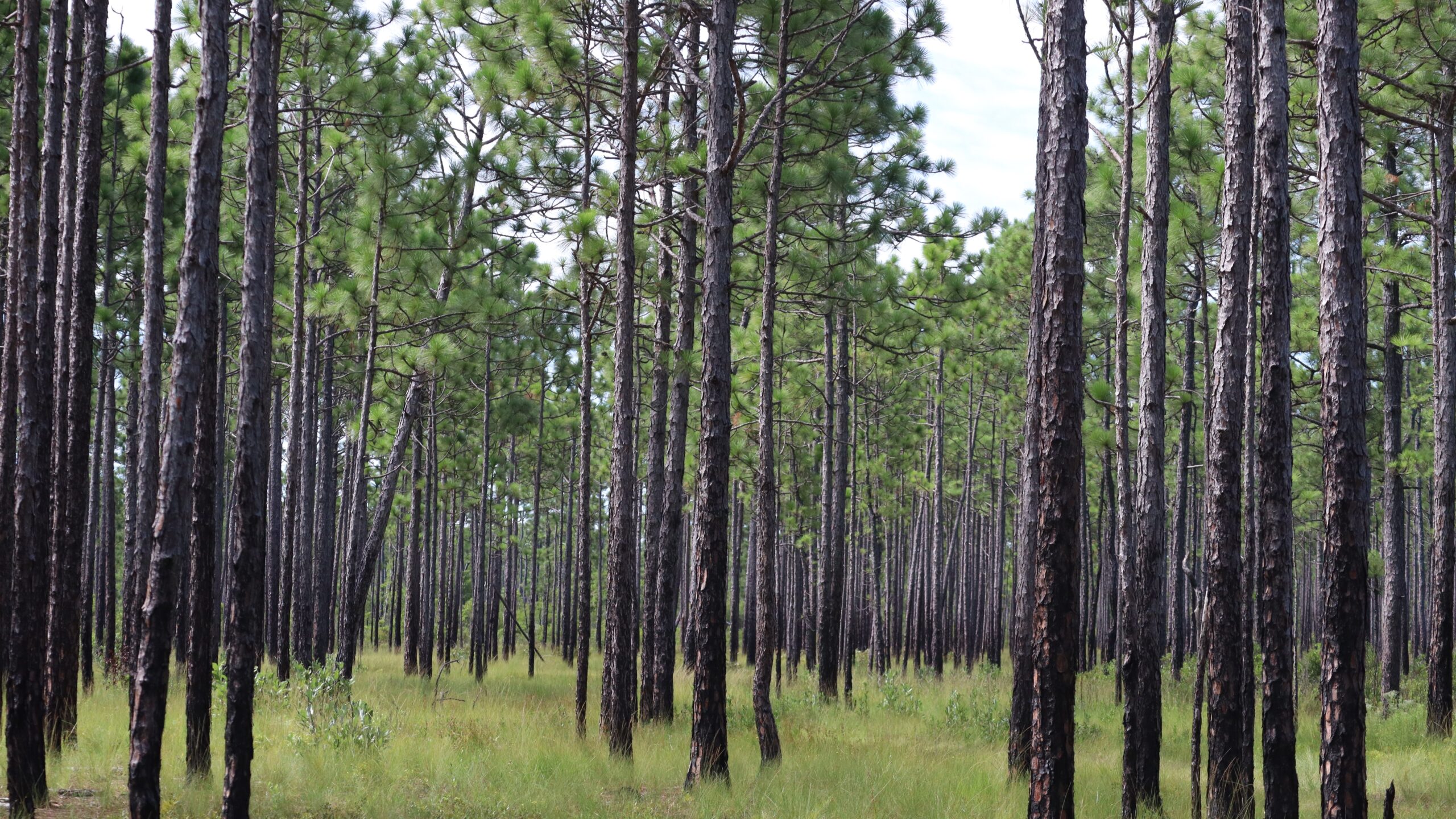New Publication Reveals Fire Managers’ Perspectives on the Future of Prescribed Fire in the SE

A new SE CASC supported article, Prescribed fire in longleaf pine ecosystems: fire managers’ perspectives on priorities, constraints, and future prospects, was published in the journal Fire Ecology in November 2022. The study was written by SE CASC Principal Investigator John Kupfer (University of South Carolina) and Co-Investigators Kirsten Lackstrom (University of South Carolina), Kirstin Dow (University of South Carolina), Adam Terando (SE CASC), Kevin Hiers (Tall Timbers Research Station), and researcher John Grego (University of South Carolina).
The publication is part of the SE CASC project Understanding Prescribed Fire Management in the Context of Climate Change and Landscape Transformation.
Longleaf pine is an iconic Southeastern species that played an important role in America’s history but has become a prominent focus of conservation efforts following more than a century of losses to development, agriculture, and conversion to industrial forest types. The prevention and suppression of fires, which used to occur within the landscape at intervals of every one to four years, has also altered forest structure and composition and led to fuel build up, damaging the traditionally open-canopy of healthy longleaf pine ecosystems. The loss and degradation of longleaf pine ecosystems has, in turn, had negative impacts on important keystone species such as the gopher tortoise and red-cockaded woodpecker, which is the only species of woodpecker to excavate cavities in live pine trees.
Prescribed burning is a key management tool for managing and restoring longleaf pine ecosystems, but current burn frequencies often fall far below historic burn intervals. Barriers to burning identified in the scientific literature include proximity to human development, public concerns, and risk aversion, as well as challenges posed by weather, air quality restrictions, and lack of personnel, equipment, or funding.

There is an expectation within the scientific community and among fire managers that opportunities to burn may be further reduced over the next 30 years due to a suite of evolving regional stressors. Human population density, rates of land use conversion, and extent of urban systems are all projected to increase dramatically in upcoming decades, altering the landscape context within which longleaf pine forests are embedded. These changes will occur at a time when the region is expected to experience significant shifts in climate that will impact fire weather, alter wildfire regimes, and narrow the available window for setting prescribed fires.
To facilitate the widespread application of prescribed fire throughout the region as a means for managing and restoring longleaf pine ecosystems, more information is needed on the factors that shape burning practices and how managers have interpreted changes to the longleaf pine ecosystem and in turn their burn regimes. This study seeks to address that need and quantify the relative importance of different constraints to prescribed burning based directly on input from southeastern longleaf pine fire managers. The authors also wanted to understand how fire managers expect factors to change within the next 30 years and how managers currently prioritize burn sites.
Utilizing a web-based survey that was distributed through the Southern Fire Exchange and the Southeast Regional Partnership for Planning and Sustainability, the authors received input from roughly 300 fire managers to answer three main questions:
- What are the most common criteria that practitioners use to decide where to burn to achieve management objectives in their longleaf pine ecosystems?
- What are the primary factors that constrain the implementation of prescribed burning in their management units?
- How do managers expect burning constraints and the availability of suitable burning conditions to change over the next 30-50 years?
Results of the study show that time since the last fire, ecosystem health, fuel reduction, and management of threatened or endangered species were top priorities for a majority of respondents, with slight differences between respondents who managed private vs. public lands. In the open response portion of the survey, respondents highlighted the importance of reducing competing species, promoting longleaf pine growth, improving a site’s fuel conditions, and the ability to conduct safe burns in the decision process. The most common legal, institutional, and managerial constraints were the nearby presence of human developments and risk aversion, while key environmental and resource constraints were seasonal fire weather characteristics, including those associated with temperature, drought, days since the last rainfall, wind speed, relative humidity, and smoke dispersion. Given these constraints, many respondents (38%) cited recent burn frequencies that fall short of historic burn intervals, with others expressing a desire to burn more frequently to achieve specific management goals.
Kirsten Lackstrom, co-author of the study, says “Our results point to the fact that managers are currently working to optimize the resources and opportunities available to them but the myriad of challenges they face make it hard to maintain their desired burn regimes.”
Looking to the future, roughly half of the survey respondents expect that the availability of suitable burning opportunities will be reduced over the next 30 years due to land use and urban change as well as climate change, particularly during the growing season.
The authors conclude with a few recommendations for the design and implementation of future burning strategies that target the long-term restoration of longleaf pine ecosystems:
- Evolving fire management plans need to account for the intersection between legal, institutional, and managerial constraints that frame fire management with operational factors such as weather and organizational capacity that dictate day-to-day decisions.
- Fire management strategies should be aligned in objectives and priorities across boundaries (e.g. ownership types).
- Strategies need to account for time scales of multiple constraints (operational constraints and capacities, policy and legal frameworks, and long-term environmental trends).
This study provides a first-hand account of the constraints and challenges faced by fire managers in the southeastern U.S. As John Kupfer, lead author of the study, notes: “Our work suggests that proactive and flexible management approaches that consider future environmental challenges will be needed to successfully conserve and rehabilitate the historic longleaf pine ecosystem.”
Note to editors, the abstract follows:
Kupfer, J.A., Lackstrom, K., Grego, J.M. et al. Prescribed fire in longleaf pine ecosystems: fire managers’ perspectives on priorities, constraints, and future prospects. fire ecol 18, 27 (2022). https://doi.org/10.1186/s42408-022-00151-6
Abstract:
Background
Projected trajectories of climate and land use change over the remainder of the twenty-first century may result in conditions and situations that require flexible approaches to conservation planning and practices. For example, prescribed burning is a widely used management tool for promoting longer-term resilience and sustainability in longleaf pine ecosystems of the southeastern United States, but regional stressors such as climatic warming, changing fire conditions, and an expanding wildland-urban interface may challenge its application. To facilitate the development of fire management strategies that account for such changes, we surveyed nearly 300 fire managers to elicit information on the criteria used for prioritizing burn sites, current burning practices and constraints, and expectations for changes in burning opportunities, including those pertaining to climate change and urban growth.
Results
Respondents noted that their most common criteria for selecting longleaf pine stands for burning were fire history, ecosystem health, and fuel reduction, with the presence of threatened and endangered species also given priority by public land managers. Many respondents (38%) cited recent burn frequencies that fall short of historic burn intervals. Barriers to burning included legal, institutional, and managerial constraints, such as proximity to human developments, public concerns, and risk aversion, as well as environmental and resource constraints, including weather, air quality restrictions, and lack of personnel, equipment, or funding. Roughly half of all respondents expect that opportunities to burn will be reduced over the next 30 years, particularly during the growing season. Fire manager perceptions of factors that will limit prescribed burning in the future include a similar suite of constraints, many of which will be affected by projected regional changes in land use and climate.
Conclusions
On an organizational level, burn window availability and resource limitations constrain prescribed burning practices. More broadly, policy and legal frameworks coupled with trends in urbanization and climate change are expected to interact with operational constraints to challenge managers’ abilities to implement landscape-scale burning strategies and achieve restoration goals. Additional research and engagement with fire managers are needed to investigate opportunities for introducing policy flexibility, leveraging shared management interests, and developing creative solutions to expand burning opportunities.
- Categories:
